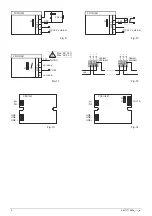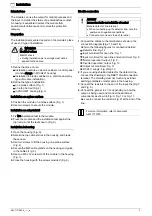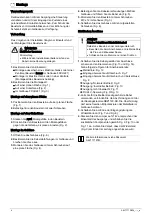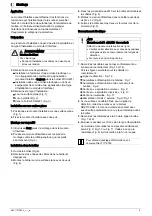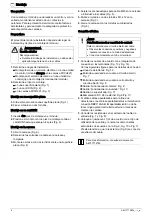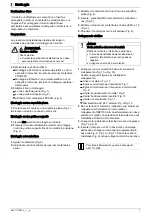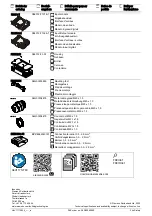
A6V11712824_----_a
3
en
Installation
Intended use
The module can use the output for control purposes and
the input to monitor the status of a potential-free contact.
A housing is available to protect the module from
environmental influences and to raise the protection
category.
Preparation
The installation procedure depends on the module's place
of use and type of installation.
WARNING
Electrical voltage
Electric shock
·
During installation work, voltage must not be
applied to the cables.
1.
Define the place of use.
–
Installation outside an electric cabinet or control panel
(module always in FDCH221 housing)
–
Installation in electric cabinet or in control panel (any
type of module installation)
2.
Define the type of installation.
–
on a plane surface (Fig. 1)
–
on a top hat rail (Fig. 2)
–
in FDCH221 housing (Fig. 3)
Installation on a plane surface
1.
Position the module on a plane surface (Fig. 1).
2.
Use two screws to secure the module.
Installation on a top hat rail
1.
Fix two installation feet to the module.
2.
Press the module and the installation feet against the
top hat rail until the feet snap in (Fig. 2).
Installation in housing
1.
Open the housing (Fig. 6).
2.
Determine the cable entries in the housing and break
these open.
3.
Use two screws to fit the housing on a plane surface
(Fig. 4).
4.
Secure the M20 cable glands on the housing and guide
in the cables (Fig. 5).
5.
Use two M3 x 12 screws to fit the module in the housing
(Fig. 3).
6.
Close the housing with the screws provided (Fig. 6).
Electric connection
NOTICE
Incorrect polarity and reliability of contact
Module defect or line interrupt
·
When connecting up the detector line, note the
positive and negative connections.
·
Connect only one wire to each terminal.
1.
Connect the cables to the terminals as shown in the
connection diagram (Figs. 13 and 14).
Refer to the following figures for connection details:
–
Detector line: Fig. 12
–
Input monitored for open line: Fig. 7
–
Input monitored for open line and short circuit: Fig. 8
–
'Normal operation' output: Fig. 9
–
'Inverted operation' output: Fig. 10
–
Output not monitored: Fig. 11
–
DC 24 V supply: Fig. 9/Fig. 10
2.
If you are using shielded cables for the detector line,
connect the shielding to the DBZ1190-AB connection
terminal. The shielding must not touch any extrinsic
earthing potentials or metal parts in the housing.
3.
Connect the resistors to the end of the input line (Fig. 7
and Fig. 8).
4.
Connect the jumper to J1/J2 depending on how the
output is being used and connect the additional
components as shown in Fig. 9, Fig. 10 or Fig. 11.
Be sure to connect the resistor (Fig. 9) at the end of the
line.
For more information, refer to document
A6V11712780.


